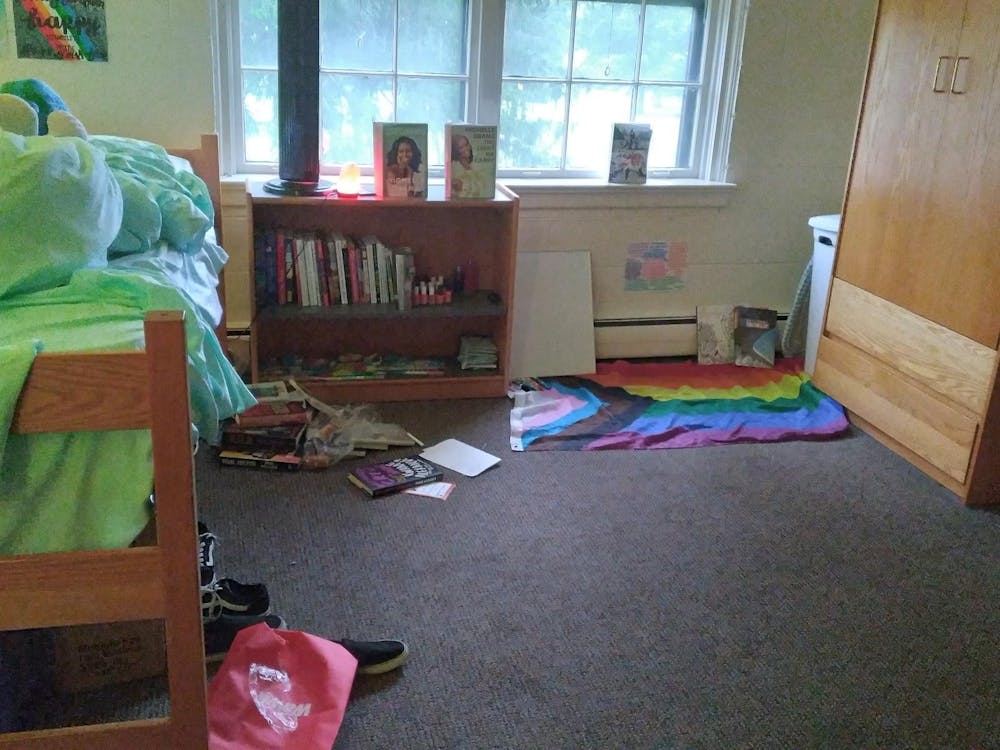Forbes may be full of doubles and occasional triples, but believe it or not, there are many students in Forbes who live in singles — myself included. And I absolutely love it! I can wake up at 6 a.m. for my 10 a.m. classes without disturbing night owls. I can invite my friends over and not have to inform someone in advance. But most importantly, I can better accommodate my sensory needs. Whether you are neurodivergent or in the market for calming dorm accessories, here are five ways I make my single room sensory-friendly.
1. LED Strip Lights
When my mom binge-watched college dorm tour videos the summer before my freshman year, she insisted I add LED lights to my college wishlist. This is because naturally the lights in some college dorms are dim, making it harder to see what you’re doing. At first, I thought they were an unnecessary distraction because they competed against my former roommate’s fairy lights on her side of the room. However, my LED lights, in retrospect, remain one of my best investments.
The LED lights are strung on my right wall, and just like last year, I’m able to change the colors with the accompanying remote control depending on my mood. If I’m getting ready for bed, my lights are blue to calm me. If I’m hyperfocusing on a project or one of my many special interests, my lights are green. Or, if I have a particularly good day, my lights are yellow to reflect my joy.
The colors may seem bright when viewed on Amazon, but they have never caused me throbbing headaches. This speaks volumes, considering that bright lights are a major sensory trigger for me.
2. Flexible Seating
Now that I have over 170 square feet all to myself, which is huge for a single at Princeton and especially at Forbes, one of my goals during move-in this year was to create more spots to work and decompress in my room. This way, I can utilize as much of the space as possible.
One corner of my room has a Pride banner laying on the floor, with two throw pillows for decoration and one lounge pillow I use for sitting up. Of course, there’s always my desk and my bed for when I don’t want to travel too far.
The great thing about my flexible seating arrangements is that I’m not tied to any one spot. I enjoy having variety while also sticking to a familiar routine to some extent, so it’s not unusual for me to switch my location two, three, or even four times in a single work session in my room to keep things interesting.
3. Sam, my stuffed dog
I owned a lot of stuffed animals when I was a baby; most of them are now packed away in moving boxes. It was not until one day in seventh grade that I rediscovered a medium-sized white dog with floppy caramel ears, a caramel sweatshirt with his picture on it, and a semicircle-shaped caramel patch over his left eye. I named him Sam, and the rest is history. For the past seven years, this plush dog has slept with me.
Sure, he can’t respond to discussion posts nor write research papers on my behalf. Nor can he talk back to me about my day. Still, the tighter I hold Sam at night, the more I can feel my sadness, anger, and doubt slip away. This is especially the case considering I’m a hugger, and I can’t randomly go to students across the hall to show them this kind of affection; I barely know them! But I digress. I can proudly say that over the years, Sam has been — and will continue to be — a wonderful emotional support buddy.

4. Samefoods
In the neurodivergent community, samefoods are foods that we enjoy gravitating towards because of the consistent taste and texture that they provide. I was notorious in my zee group for ordering Chipotle almost every week. I still do. What can I say? The freshness of the corn, steak, pico de gallo, and white rice hits differently at night.
At the time of writing this, my other samefoods include Talenti Sea Salt Caramel Gelato, bananas, BBQ ribs, and edible chocolate chip cookie dough by The Cookie Dough Café from Shark Tank. All these stay in my mini fridge full-time, though I pack some of them, like bananas, in my bag when I’m away from my dorm. They are great to snack on when the dining halls are closed. Beyond that, they come in handy when I feel too overstimulated to sit in the dining hall to have a formal meal. I’ll even sneak, say, my Chipotle bowl into the dining hall if the food being served that day is not allergen-free. This keeps me connected to eating with friends.
My samefoods, like my LED lights, reflect my mood. So it’s important that I’m adjusting my eating patterns and habits to match my energy levels, whether I need to give myself more rest or more stimulation during any particular day.
5. Pop It Bracelets
Those who are close to me know that I wear two pop it bracelets on my left arm almost every day. While some students or professors may think that they are fashion accessories (they’re not wrong; sometimes I do match my bracelets with my outfits), I mainly use pop it bracelets to relieve stress, increase concentration, and cope with sensory overload by popping the bubbles. What matters is the comfort of knowing my pop it bracelets are always on me.
In recent months, I have worn them in photos with my a cappella group, Acapellago; my church group, Princeton Presbyterians; and my job as one of the Pace Center’s Community Action Fellows to reinforce to others the fact that I belong to neuro-inclusive spaces. Besides, it is my hope that when other neurodivergent Princeton students see me with my sensory tools, they will gradually feel more comfortable to use and display theirs in public.
Avery Danae Williams is a staff writer for The Prospect and a prospective African American Studies major with a certificate in Creative Writing. You can reach her at averyd.williams@princeton.edu or view her writing portfolio, linktr.ee/unpackingmyworld.









